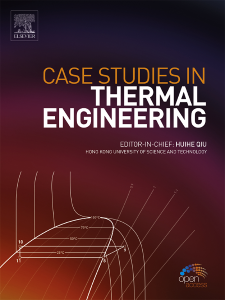Ray tracing design-optimization & experimental validation of water based optical filter to reduce solar PV module heating
IF 6.4
2区 工程技术
Q1 THERMODYNAMICS
引用次数: 0
Abstract
The operating temperature of a photovoltaic (PV) module significantly impacts its efficiency. Increased temperatures reduce the efficiency due to a negative thermal coefficient, which decreases its power above standard test conditions (25 °C, 1000 W/m2). This research targets the reduction of thermal load on PV modules through the incorporation of a water-based optical filter, designed and optimized using ray tracing techniques. The optimal thickness for the glass was determined as 3 mm and 5 mm for the water layers of the filter, providing the best yield. The filter effectively absorbs 92 % of the infrared radiation and 47 % of the ultraviolet spectral flux, significantly reducing heat-induced efficiency losses in the PV module. Water-based optical filter system reduces the module temperature up to 9.80 °C. The optical filter-based PV system achieved a 4.56 % increase in electrical efficiency compared to the reference module, with an average efficiency of 12.19 %. The heated water, reaching up to 48.25 °C, can be reused for various industrial processes, providing both cooling for PV modules and a hot water source, making it versatile and efficient for regions needing both electricity and hot water.
用于减少太阳能光伏组件发热的水基光学滤波器的光线跟踪设计优化和实验验证
光伏(PV)组件的工作温度对其效率有很大影响。温度升高会因负热系数而降低效率,超过标准测试条件(25 °C,1000 W/m2)会降低功率。这项研究的目标是通过采用光线跟踪技术设计和优化的水基光学滤光片,降低光伏组件的热负荷。玻璃的最佳厚度被确定为 3 毫米,滤光片水层的最佳厚度为 5 毫米,从而获得最佳效果。该滤光片可有效吸收 92% 的红外线辐射和 47% 的紫外线光谱通量,从而显著降低光伏组件中由热引起的效率损失。水基光学过滤器系统可将组件温度降低至 9.80 °C。与参考模块相比,基于光学过滤器的光伏系统的电效率提高了 4.56%,平均效率为 12.19%。加热后的水温高达 48.25 °C,可重新用于各种工业流程,既可为光伏组件提供冷却,又可作为热水来源,对于同时需要电力和热水的地区来说,用途广泛且高效。
本文章由计算机程序翻译,如有差异,请以英文原文为准。
求助全文
约1分钟内获得全文
求助全文
来源期刊

Case Studies in Thermal Engineering
Chemical Engineering-Fluid Flow and Transfer Processes
CiteScore
8.60
自引率
11.80%
发文量
812
审稿时长
76 days
期刊介绍:
Case Studies in Thermal Engineering provides a forum for the rapid publication of short, structured Case Studies in Thermal Engineering and related Short Communications. It provides an essential compendium of case studies for researchers and practitioners in the field of thermal engineering and others who are interested in aspects of thermal engineering cases that could affect other engineering processes. The journal not only publishes new and novel case studies, but also provides a forum for the publication of high quality descriptions of classic thermal engineering problems. The scope of the journal includes case studies of thermal engineering problems in components, devices and systems using existing experimental and numerical techniques in the areas of mechanical, aerospace, chemical, medical, thermal management for electronics, heat exchangers, regeneration, solar thermal energy, thermal storage, building energy conservation, and power generation. Case studies of thermal problems in other areas will also be considered.
 求助内容:
求助内容: 应助结果提醒方式:
应助结果提醒方式:


